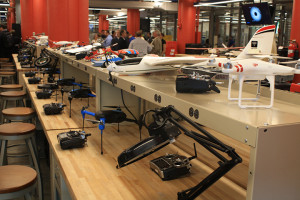On August 24, Sinclair Community College officially cut the ribbon to open the brand-new National UAS Training and Certification Center, giving students new capabilities in seeking the opportunity to work with UAS (unmanned aerial systems) in an immersive and hands-on environment, backed up with leading-edge technologies and instruction.
The new center features a renovation of 28,000 square feet of Building 13, which houses state-of-the-art learning spaces, a wind tunnel, engine testing capabilities, expanded simulation lab, sensors and avionics stations alongside advanced and additive manufacturing machines.The new facility also is to support
the integration of the college’s manned aviation programs by housing two simulation training devices and resources for the college’s airframe and power plant (abbreviated A&P) program.
As of now, the new UAS Center will be one of the only programs in the United States to provide training for both manned and unmanned aerial systems. New additive and advanced manufacturing equipment allows for the design, production
and testing of UAS and related components, taking ideas from the initial planning phase to a completed, functioning prototype.
“Wilbur Wright, one of the famous brothers from Dayton who invented manned aviation, said to be successful, began his life in Ohio. Today, Ohio and Dayton are again at the center of a new generation of aviation: unmanned aerial systems, thank to the National UAS Certification and Training Center at Sinclair
College,” said Brian Wynne, the president and CEO of the Association of Unmanned Vehicle Systems International, or AUVSI.
“Sinclair is providing Ohioans with access to innovative instruction to research to help them launch fulfilling careers in the burgeoning field of UAS, which according to an AUVSI report is forecast to create thousands of jobs across Ohio and the nation during the next several years. So, to be successful, begin life in Ohio, and
to be successful in UAS, begin your career at Sinclair,” said Wynne.
Outlining the potential economic impact of the program, Sinclair President Steve Johnson said, “With unmanned aerial systems, we’re looking at an industry that’s forecast to yield more than 100,000 jobs nationally and an economic impact of $82 billion over the next 10 years.”
“The opening of the National UAS Training and Certification Center at Sinclair puts the Dayton region at the forefront at what’s shaping up to be the next step in aviation technology,” Johnson said.
“This is an exciting time for the college and the UAS industry, as we are seeing the culmination of several years of hard work, industry partnerships and state support creating a sustainable future for a growing industry.” Mr. Johnson also
The State of Ohio Controlling Board granted a release of $4 million to Sinclair to help move forward with the goal of opening the new UAS Center. That was added on to the $1 million that Sinclair had already invested in the program. Now, a new partnership with UAS simulations system provider Simlat has given even more tools for students. Simlat is planning to provide students at the UAS Center with a leading-edge resource for simulated flight operations called the UAS Simulation Lab.
This new lab, housed in Building 13, will feature leading simulation systems in a 20-seat classroom broken down into five student stations with one instructor. The lab will also feature a Simlat IMPACT System, which offers customized scenarios, performance assessments and training research capabilities. Additionally
the simulation system provides access to already exisiting Sinclair ground control systems, giving the students the opportunity to train in the lab and on actual vehicles that are already in Sinclair’s fleet.
“We are extremely proud to have the opportunity to establish this
partnership with Sinclair College. The National UAS Center is a great fit for a Simlat system, which offers cutting-edge simulation configurations for commercial, civil and military training applications,” said Yuval Peshin, president of Simlat.
Deb Norris, the Vice President for Sinclair Workforce Development had this to say, “This new addition to the National UAS Training and Certification Center will provide a broad range of capabilities to students training on UAS, including supporting research and development. This is our first system to feature active
sensor simulation, which sends out signals from the vehicle and receives information back, an important training component for vehicle operation.”
The brand-new Sinclair course for UAS is called just that: Unmanned Aerial Systems. It is a one-year technical certificate program that takes 33 credit hours to complete on time. There are five specialty UAS courses within the Aviation program
that students can take to complete the certificate. They are:
1. AVT 1001: Introduction to Unmanned Aerial Systems
2. AVT 1004: UAS Standards, Regulations & Law
3. AVT 1110: Private Pilot Ground School
4. AVT 2150: Crew Resource Management for UAS
5. AVT 2151: UAS Operations
There are also several Electronics Engineering Technology courses to take
1. EET 1120: Introduction to DC/AC Circuits
2. EET 1121: UAS Remote Sensing and Analysis
3. EET 1158: Aerospace Spatial Visualization
You must also take ENG 1101: English Composition I, MAT 1470: College Algebra, MET 1311: Personal Computer Applications for Engineering Technology and SCC
101: First Year Experience along with your choice of a litany of elective courses. The UAS program has been designed to prepare students with the foundational knowledge and skills involving UAS technology, regulations and laws required by industry necessary tools needed to work with Unmanned Aerial Systems as a pilot/operator, an observer, and ancillary ground crew member while applying an understanding of the operational and safety regulations governing the National Airspace System.
Christopher Witt
Reporter

